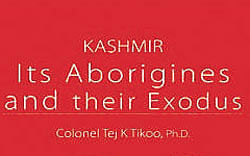Scores of books have been written in the recent years on the vexed and seemingly-endless conflict in and over Jammu and Kashmir. This voluminous tome is a welcome addition to the growing corpus of writings on the subject.
Kashmir — Its Aborigines and Their Exodus focuses in particular on what the author, a retired Indian Army officer with years of experience in tackling insurgency in Jammu and Kashmir, terms as Kashmir’s ‘aborigines’ or indigenous people — the Kashmiri Pandits, who are the only major remaining Hindu community in the Kashmir Valley. Colonel Tej K Tikoo provides us the perspective of an insider, as he, himself, is a member of this community.
Col Tikoo gives us a broad historical account of the Kashmiri Pandits, starting from the early Aryan period down to the present day. He tells us much about the amazing contributions and achievements of the Kashmiri Pandits in a range of fields down the centuries: art, religion, culture, politics and administration, in particular. Even when Kashmir passed under Muslim rule, when the majority of Kashmir’s indigenous and largely Hindu and Buddhist population, converted to Islam, and conditions were hardly propitious for them, the Kashmiri Pandits, Col Tikoo writes, never ceased to maintain their traditions and their separate identity. During the centuries of Mughal and Afghan rule, Col Tikoo tells us, the Pandits had often to face severe persecution on account of their religion, but yet they persevered and refused to cave in to the enormous pressures they were faced with.
Much of this book deals with the origins of the Kashmir dispute and the course that the conflict, involving India, Pakistan and radical Islamists, has taken. Col Tikoo contends that apart from economic and political issues, religion — or, to be more particular, certain radical and supremacist versions of it — have played a central role in further complicating the conflict.
Radical Islamists see the conflict as nothing less than a jihad, and that has made the issue even more intractable than it was. It would thus appear that a lasting solution to the Kashmir conflict must also involve a rethinking of deeply-rooted understandings of religion that are premised on communal supremacism.
In this regard, Col Tikoo critiques oft-heard appeals to “Kashmiriyat” by those who want to deny or overlook the reality of religion-based conflict in Kashmir, contending that those who glibly deploy this slogan conveniently ignore a history of oppression in the name of religion in Kashmir, although he does recognise a counter-tradition of communal harmony preached by such renowned Kashmiri mystics as Lal Ded and the Kashmiri Rishis, who counted both Hindu as well as Muslim admirers. Yet, he writes, these voices of love and compassion transcending religious boundaries seem to have been drowned out by radical elements who see people of different religions as inveterate foes.
Col Tikoo recounts the horrors that the Kashmiri Pandits have had to face in the wake of the outbreak of violence in Kashmir towards the end of the last century, which then led to almost the entire community being forced to leave their homes and migrate to other parts of India.
He movingly describes the enormous trauma they have had to contend with, in terms of immense economic, cultural and psychological damage. He argues that many Kashmiri Pandits would like nothing more than to go back to Kashmir, and suggests several measures for the government to consider and act upon in order to ensure that they can indeed return to the land of their forefathers and live there in honour and safety.
Writing on an issue like the Kashmir conflict is hardly an easy task. Opinions on this emotionally-charged subject are sharply polarised. Almost inevitably, one’s position on the conflict is heavily determined by one’s ethnic, religious, and political background, and this is perhaps reflected in this book as well.
Critics may contend that this book is somewhat one-sided and partial. There might be others who have a different complaint, though — that the book is simply too voluminous for many people to have the patience to read and even simply too heavy to hold! But there is no denying that this is a work of considerable effort.
